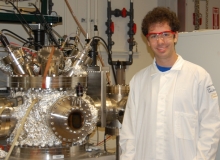
Major:
University:
Mentor(s):
Faculty Sponsor(s):
Faculty Sponsor's Department(s):
Project Title:
Project Description:
The ability of variable capacitors to store differing amounts of charge per unit voltage holds the potential to create new microwave frequency devices for telecommunication purposes. One such parallel-plate capacitor involves two platinum electrodes with a thin film of the dielectric Barium-Strontium-Titanate (BST) between them. In order to maximize the efficacy of this device, each layer must be as smooth and uniform as possible. The platinum electrodes however can suffer from surface anomalies and impurities during their growth process. In order to optimize the quality of these films and consequentially the devices, several factors and conditions leading to the anomalies were examined. The sputtering pressure, plasma power, anneal time, and anneal temperature were varied, and the subsequent surface anomaly concentration was measured via optical microscopy. Impurities in the platinum were found using thin film X-ray diffraction (XRD). Analytical techniques including Analysis of Variance (ANOVA) were then performed on the subsequent data to determine which factors most affected the quality of the film.
